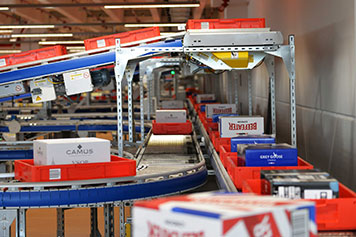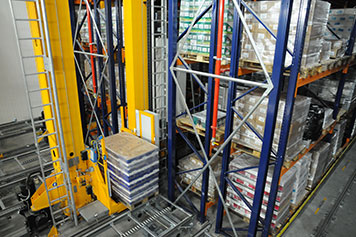Core processes
- Management
- Coordination
- Monitoring
- Control
- Optimization
What does material flow control stand for?

Already in the mid 1970s, parallel systems for the management and control of the flow of materials and information were used for the first time in building the first automated High Bay Warehousing (HBW). Thus, the foundation stone was laid to reduce the transport and handling costs and to reduce unnecessarily incurred costs.
Today, the material flow control is considered as the central nervous system of warehouses and production supply facilities. Hierarchically, it is positioned between warehouse management systems (WMS) and programmable logic controllers (PLC) and it features integrated control functionality for the management, coordination, monitoring and control of resources and transport, as well as for the organisation of replenishment for picking activities.
The VDI guideline 3300 defines material flow as "Concatenation of all processes for harvesting, machining and processing, as well as distribution of material goods within specified areas". The task of material flow control is to synchronize all information and goods flows so that parts are at disposal at the right time in the right place, in the desired quality and quantity. Transport jobs can be assigned by both the enterprise resource planning (ERP) system as well as by the warehouse management system (WMS) to the material flow control. Generated event messages are displayed on the visualisation or monitoring devices. Statements regarding capacity utilisation, system state, and ready signals can be issued (e.g. pallet has arrived at the destination). With a plant visualisation (e.g. WinCC), the level of detail extends down to the sensor and actuator level and thus provides an early troubleshooting of loopholes or even acute interferences and their remedies as well.
In short, material flow control is responsible for the implementation of individually appropriate actions and movements of goods from goods receipt, via warehousing and picking up to the dispatch. Moreover, material flow control coordinates and optimises their sequence, continuously controls all the source / sink relations relevant to the order processing and issues commands to the subordinate logic controllers (PLC) via telegram protocol (e.g. TCP/IP).
Through implemented control strategies, also certain procedures can be put in place; hence, defined objectives can be achieved sensibly and efficiently. In particular, factors to reduce costs, to improve performance and to implement quality assurance are in focus. Central approaches that the material flow control has to follow are the push-and-pull principle. While the push principle is oriented towards sales and plan data, the pull strategy focuses on a demand-driven, automated planning and control of processes and goods' movements. Costs for storage can be reduced just as capital commitment can be eliminated by high stocks and redundant activities.
Functional areas
- Transport management
- Outputs of drive commands
- Allocation of routes and conveyance means
- Routes and capacity optimisation
- Replenishment organisation
Which tasks does material flow control entail?

The central task of material flow control is a rationally thought out transaction - focused on optimised business administrative costs - of all relevant partial processes in the intra- and production logistics. The material flow control takes on tasks within the scope of transport management and commissioning with driving tasks and coordinates the assignment of conveyance routes with appropriate means. It caters for an optimum routing and the best possible utilisation of routes and resources, organises the replenishment for picking and initiates a permanent inventory. The execution of transport orders, however, is subject to the subordinate controllers (PLC) for automatic high-bay warehouses, small parts storage, conveyance means, etc.
High demands are put on the material flow control, particularly focused at the peaks when systems operate under high load and a variety of conveyance means has to respond to transport requests in parallel. These trips are to be coordinated and controlled such that freed resources are occupied immediately, the system is not blocked, the goods are brought to their destination via the shortest route and throughput capacity is kept constant. With this background, orders are to be prioritized where appropriate.
Short name
- SAP
- MFR
- MFS
- SPS
- LVR
- WMS
- ERP
Which advantages does the material flow control offer with SAP standard software?
The warehouse management system from SAP is the SAP extended warehouse management (SAP EWM) that together with the SAP material flow system (SAP MFS) provides an integrated component for material flow control. The SAP MFS can be connected to one or several programmable logic controllers (PLCs) to ensure the flow of materials. This interaction ensures smooth, safe and efficient material flow movements in automated high-bay equipment (HRL), automatic small parts warehouses (AKL) for containers, shelves and trays as well as highly automated logistics and distribution centres.
For example, fully automated shuttle vehicles, aisle-bound stacker handlers, sorters and sequencer are directly controlled in an efficient manner. Advantage of this maximum SAP integration is that external middleware and subsystems are eliminated completely. Furthermore, interfaces are reduced and at the same time the planning and investment certainty is enhanced.
Users of SAP EWM / MFS will benefit from a range of functions that allows an automated handling of many steps or tasks, for example:
- Order consolidation
- Compaction and packaging processes with plausibility procedures
- Automatic identification of handling units (HUs)
- Automatic ejection of not storable HUs
- Fully automatic storage of HU´s through any number of reporting points
- Reduction of unladen trips, about doubles of the stacker cranes
- Identification of capacity limits at reporting points and conveyance means
- Activation and deactivation of conveyor segments
- Combination of conveyance means into groups
- Check of the reporting points for the warehouse management monitor
- Secure telegram traffic with the PLC level through bi-directional communication channels
The use of SAP MFS (SAP material flow system) enables a two-tier system architecture SAP SPS with seamless SAP integration, simplified interfaces, a high degree of standardisation, and significant cost savings in ongoing operations, maintenance and support. The homogenised system landscape eliminates sources of error and ensures optimum data transparency. This results in significant efficiency gains in the picking process in the packaging and dispatch unit.
The automatic control in the warehouse, logistics or distribution centre occur directly from SAP. Through the SAP EWM integrated material flow component SAP MFS, a close link between the flow of material and optimisations can be achieved with the warehouse management at central locations and in a system. This facilitates the comparison of deposited control strategies, as well as the resource utilization at the mechanics level. Multi-order-picking and Value-added Services according to the principle "Goods to the person" are also possible, such as multi-level input and retrieval processes, as well as the multi-depth storage of small parts.
SAP MFS submits the trip orders in real time directly to the PLC of the rack feeders or to the connected conveyance means. Input and retrieval strategies are fully deposited in SAP MFS and process improvements can be undertaken at any time, for instance through equipartition of articles and/or route-optimised storage location determination. Even complex conveyor system layouts, which extend over several levels including buffer and sorting tracks, can be fully depicted in the SAP MFS. In the case of outages, dynamic diversion strategies can be enabled, which maintain the availability of the system. Special functions and ergonomic SAP dialogue support the pickers in the workplace through comfortable easy-to-use, easy-to-solve user dialogues.
With the SAP extended warehouse management (EWM) and the SAP material flow system (MFS) for connecting automated storage technology components, a high-performance platform for control and optimisation of intra logistic processes is available. The use of proprietary material flow system or subsystems, even in highly automated logistics systems such as automatic small-parts warehouses or shuttle systems, for pick & pack functions, for the connection of automated storage technology or forklift control systems and for the use of RFID technology are no longer required - just to mention a few examples.
Users benefit from a consistent, transparent and extremely efficient SAP IT system architecture from the business process level down to the subordinate controls. All logistical processes in the warehouse, but also in the field of production supply can be fully depicted in SAP. The support and development of SAP EWM / MFS are ensured in the long term.


